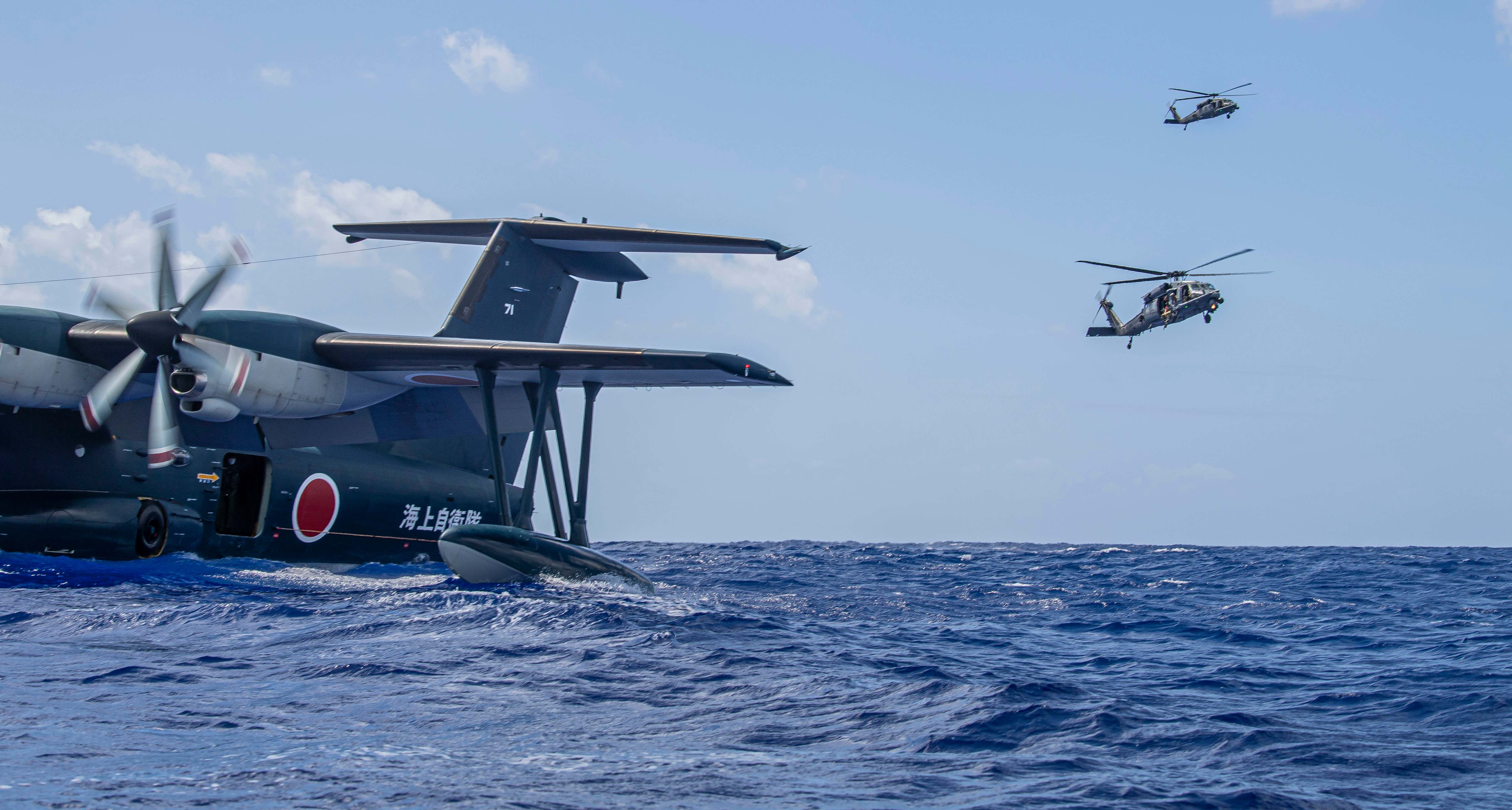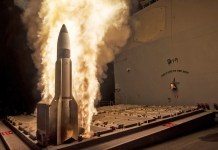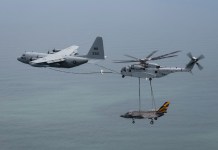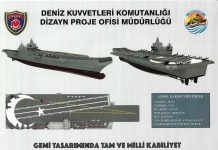Only a few countries in the world have amphibious aircraft that can fly as well as swim. Even as the US boasts the biggest and most advanced aircraft fleet in the world, it does not possess an amphibious plane yet.
During the Cope North exercise held recently, US Air Force airmen got up close and personal with the Japanese ShinMaywa US-2 amphibious aircraft.
A plane that can take off and land on both land and water is referred to as an amphibious aircraft. Despite the fact that they cannot hover or land vertically, they can compete with helicopters for specialized operations at a much lower cost.
Since the wing of an aircraft is more efficient than the lifting rotor of a helicopter, amphibious aircraft can travel faster and further than helicopters.
On Feb 18, US Defense Secretary Lloyd J. Austin said the new National Defense Strategy “will certainly address major threats to our security…It’ll also address major threats to the international rules-based order”, in an indirect reference to China and Russia.
“We need 12 carriers. We need a strong amphibious force to include nine big-deck amphibs and another 19 or 20 [LPDs] to support them. Perhaps 30 or more smaller amphibious ships to support Maritime Littoral Regiments… to 60 destroyers and probably 50 frigates, 70 attack submarines and a dozen ballistic missile submarines to about 100 support ships and probably looking into the future about 150 unmanned,” (sic) Adm. Gilday said.
It is believed the US Air Force service is looking to develop an amphibious variant of the C-130 Hercules transport to serve special operations from littoral locations.
With a huge American presence in the Pacific and Indo-Pacific region and allies in island states, wielding an amphibious plane for contingency becomes imperative. Further, increasing tensions with China in the Indo-Pacific region and its aggression against Taiwan warrants the US to have amphibious aircraft. It is pertinent to mention here that China possesses the world’s largest amphibious aircraft fleet, called AG600.
Aircraft with the #USMC, @usairforce, @AusAirForce, @JASDF_PAO_ENG, and regional allies conduct a flyover during Cope North 2022 at Andersen Air Force Base, Guam, Feb. 7.#CN22 is a humanitarian assistance and disaster relief exercise that occurs in multiple locations. pic.twitter.com/HVw5TyZY6f
— U.S. Marines (@USMC) February 11, 2022
Cope North 2022 was held from February 2 to 18 and involved roughly 3,500 soldiers and 130 aircraft from the air forces of Australia, Japan, and the United States. Air combat, large-force deployment, and humanitarian assistance and disaster relief (HA/DR) exercises were all part of the drills.
A Japan Maritime Self-Defense Force (JMSDF) US-2 was seen operating in the ocean near Andersen Air Force Base of the US at Guam as part of a HA/DR training scenario, according to photos released by the US Department of Defense recently.

JMSDF personnel worked with US Air Force HH-60G Pave Hawk which is its primary combat search and rescue aircraft from the 33rd Rescue Squadron, based at Kadena Air Base in Japan.
Why Is US-2 Special?
The US-2 amphibious aircraft operated by the Japan Marine Self-Defense Force used for search and rescue, maritime patrol, firefighting, medical evacuation, and logistical support missions. It was the world’s largest amphibious plane until China’s AG600 flew for the first time in 2017.
Four turboprop engines, one auxiliary engine, and a boundary layer control (BLC) engine power the aircraft. BLC is the mechanism for maintaining lift at low speeds without stalling by regulating the layer of air surrounding the wing of the aircraft.
Due to the risk of hull damage from high-speed waves or currents, climb-out and approach speeds for smooth takeoff and landing on the water must be slower than on land. The US-2 can fly at speeds as low as 50 knots and as fast as 315 knots owing to the BLC technology.

It has a range of 4,500 kilometers allowing it to conduct search-and-rescue missions up to the southern point of the Kamchatka Peninsula in the north, Mindanao in the Philippines in the south, and the island of Minamitorishima in the east.
The US-2 can also land on rough waters with waves as high as 3 meters, making it one of the world’s most capable flying boats.
It is powered by four 4,600 horsepower Rolls-Royce AE 2100J turboprops, has a flight deck with digital displays, can cruise at 300 miles per hour, and has a maximum range of about 3,000 miles. A combination of blown flaps and an innovative flight control system allows it to do short-takeoff and landing (STOL) maneuvers.
US Military Eyes ‘Flying Boats’
The US Air Force Special Operations Command has made it a high priority, sending Maj. Gen. Eric Hill to Japan to understand how the Japanese Self-Defense Forces operate aircraft without landing runways or aircraft carriers around the Indo-Pacific region.
In recent months, the US-2 has piqued the interest of the US Air Force as a whole. A group from the Air Force Special Operations Command (AFSOC) visited Iwakuni Air Base in Japan in November last year to learn more about the aircraft and its operations.
Iwakuni Air Base is unique as it is the only JMSDF air base which operates amphibious sea rescue aircraft US-2, MCH-101 used in both the airborne mine countermeasures and transport, and OP-3C utility aircraft equipped with image data acquisition system.
— Japan Ministry of Defense/Self-Defense Forces (@ModJapan_en) October 24, 2020
US Air Force Special Operations Command’s Maj. Gen. Hill explained that “the Indo-Pacific region has high strategic importance,” for the Air Force.
“We’re an incredibly capable air force, and while we still need to be able to land and take-off from land-based airfields, the ability to turn the Pacific Ocean into a runway would increase our options to help secure our nation’s and allies’ security interests,” Hill said.
The US Air Force Special Operations Command plans to convert some of its MC-130 aircraft to be able to land on water, giving them the provisional title MC-130J Commando II Amphibious Capability (MAC).
Japan Maritime Self-Defense Force ShinMaywa US-2 floats in the ocean while US Air Force HH-60G with 33rd Rescue Squadron hover nearby during Exercise Cope North 22 at the Island of Tinian on Feb. 14. pic.twitter.com/K8LmjNr2D9
— Ryan Chan 陳家翹 (@ryankakiuchan) February 23, 2022
The pontoons on the plane would be removable, allowing the plane to land both on land and at sea. The US Air Force also wants the system to be easily interchangeable with similar aircraft in the US Navy and Marine Corps inventories with just modest modifications, according to National Interest.
Though the US had many amphibious aircraft at one time, the feature went out of favor as the country expanded its footprint across the Pacific. Amphibious aircraft are likely to return with a vengeance, given the heightened attention on the Indo-Pacific region.
The MC-130J MAC might not be a real flying boat like the US-2 or the even larger Chinese AG600, but it will be amphibious, meaning it will be able to land on a runway with its floats in place, according to The Drive.
Combat search and rescue is one of the roles being examined for the C-130 floatplane, which has unique needs in the Indo-Pacific theater, where aircrew may need to be recovered from the water over long distances — much beyond the current fleet of HH-60G Pave Hawks, for example.
AFSOC plans operational capability demo of amphibious MC-130J ‘in only 17 months' https://t.co/Z5A15C1Ooj @usairforce pic.twitter.com/TDv6wWwRyg
— Janes (@JanesINTEL) September 20, 2021
The Air Force is currently considering future CSAR platforms, including amphibious, vertical takeoff and landing, and potentially stealth capabilities. There’s also a sense of urgency surrounding AFSOC’s future amphibious aircraft, with a plan for a 17-month operational demonstration of the MAC concept, as revealed in September last year.
- Contact the author at sakshi.tiwari9555@gmail.com
- Follow EurAsian Times on Google News





